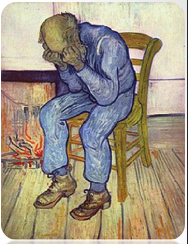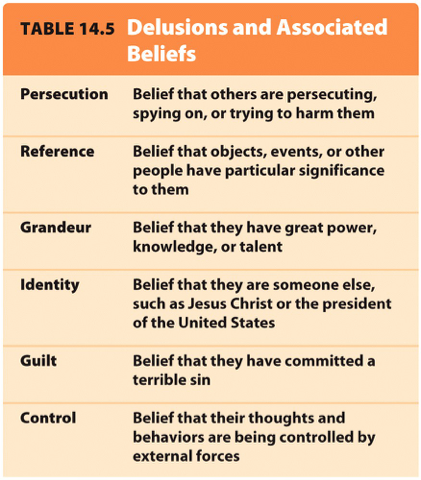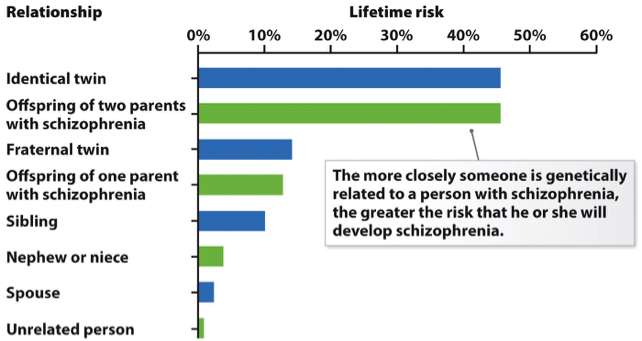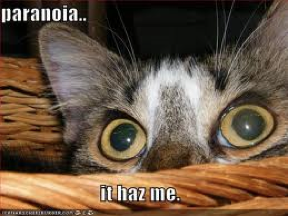Week 10 - Day 1 (Ch 11 - Pt 2)
Anouncements:
-
Homework 5 is now available
-
Due at noon on April 6th
Schizophrenia
What is Schizophrenia?
-

-
Schizophrenia: a psychological disorder characterized by a split between thought and emotion; involves alterations in thoughts, in perceptions, or in consciousness
-
split between person and reality
-
It is a psychotic disorder, the essence of which is a disconnection from reality referred to as psychosis
-
Current estimates state between 0.5 percent and 1.0 percent of the population has schizophrenia; effects women and men similarly
Types of Symptoms in Schizophrenia
-
Positive symptoms: excesses in functioning, such as delusions, hallucinations, and disorganized speech or behavior
-
Extra symptoms
-
Negative symptoms: deficits in functioning, such as apathy, lack of emotion, and slowed speech and movement
-
Deficits in fun functioning
-
Withdraw inward
-

Positive Symptoms of Schizophrenia
-
Common positive (i.e., excessive) symptoms associated with schizophrenia include:
-
Delusions: false beliefs based on incorrect inferences about reality
-
Hallucinations: false sensory perceptions that are experienced without an external source. Frequently auditory, they can also be visual, olfactory, or somatosensory.
-
External
-
Often respond aloud to these sounds they hear
-
Loosening of associations: Individual shifts between seemingly unrelated topics as he or she speaks, making it difficult or impossible for a listener to follow the speaker’s train of thought
-
Word salad
-
Disorganized behavior: Person might walk along muttering to himself, alternate between anger and laughter
-

Negative Symptoms of Schizophrenia
-
A number of behavioral deficits associated with schizophrenia result in patients’ becoming isolated and withdrawn:
-
People with schizophrenia often avoid eye contact and seem apathetic
-
They do not express emotion
-
Speech is slowed and they use a monotonous tone of voice, long pauses before answering, failure to respond to a question, inability to complete an utterance after initiating it
-
Movements may be slowed and the overall amount of movement reduced, with little initiation of behavior and no interest in social participation
-
Negative symptoms are more resistant to medications
-
Difficult to treat because "How do you make someone engage in conversation"
Biological Components of Schizophrenia
-
Genetics plays a role in the development of the disorder
-
If one identical twin develops schizophrenia, the likelihood of the other twin’s succumbing is almost 50 percent; 14 percent if the twins are fraternal
-
Genetic component of schizophrenia represents a predisposition rather than destiny
-
Does not mean that you are certain to develop it
-
Schizophrenia in the brain
-
Ventricles in the brain are enlarged and there are abnormalities throughout many brain regions
-
Might explain the extra sensory experiences
-
Schizophrenia may result from abnormality in neurotransmitters (e.g., dopamine)
-

Environmental Factors
-
Environmental stress seems to contribute to the development of schizophrenia:
-
Being born or raised in an urban area approximately doubles the risk of developing schizophrenia later in life
-
A large city like New York will increase your chances of developing the disease
-
People with schizophrenia are more likely to have been born during late winter and early spring
-
Mothers of children born in late winter and early spring were in their second trimester of pregnancy during flu season
-
Mothers of people with schizophrenia are more likely than other mothers to have contracted influenza during this critical period
-
Growing up in a dysfunctional family may increase the risk of developing schizophrenia for those who are genetically at risk
True Life: I Have Schizophrenia
http://www.mtv.com/videos/true-life-i-have-schizophrenia/1586145/playlist.jhtml
Personality Disorders

-
Personality Disorder
-
More enduring than other disorders
-
Has an onset in adolescence or early adulthood
-
Is stable over time
-
Leads to distress or impairment
-

-
Although individuals change somewhat over time, the ways they interact with the world and cope with events are fairly fixed by the end of adolescence
-
Some people interact with the world in maladaptive and inflexible ways
-
People with personality disorders:
-
consistently behave in maladaptive ways
-
show an extreme level of maladaptive behavior
-
Not just occasionally grumpy person. They're that way all of the time
-
experience much personal distress and problems as a result of their behavior
Personality Disorder Clusters
-
Cluster A:
-
Paranoid PD
-
Schizoid PD
-
Schizoptypal PD
-
Cluster B:
-
Antisocial PD
-
Borderline PD
-
Histrionic PD
-
Narcissistic PD
-
Cluster C:
-
Avoidant PD
-
Dependent PD
-
Obsessive-Compulsive PD
Cluster A Personality Disorders
-
“Odd, eccentric” cluster
-

Paranoid PD
-
Associated characteristics:
-
Tense
-
Guarded
-
Holds grudges
-
Suspicious
Schizoid PD
-
Associated characteristics:
-
Socially isolated
-
Emotionally restricted
-
Has no desire for relationships
Schizoptypal PD
-
Associated Characteristics:
-
Peculiar thoughts, appearance, and behaviors
-
Emotionally detached
-
Socially isolated
-
Superstitious
-
It's like a person who has a random weird take on things
-
Any time you have a conversation with them, they have a weird spin on it
Cluster B Personality Disorders
-
“Dramatic, emotional, erratic” cluster
-

Borderline PD
-
Associated Characteristics:
-
Cannot stand to be alone
-
Intense
-
Unstable moods
-
Unstable relationships
-
Chronic anger - outbursts
-
Suicidal tendency/self mutilation
-
Substance abuse
Borderline Personality Disorder Is Associated with Poor Self-Control
-
Borderline personality disorder: characterized by disturbances in identity, in affect, and in impulse control
-
The term borderline was initially used because these patients were considered on the border between normal and psychotic
-
Approximately 1 percent to 2 percent of adults meet the criteria for borderline personality disorder; more than twice as common in women as in men
-
Possible causes: low serotonin, trauma, or abuse
Histrionic PD
-
Associated Characteristics:
-
Seductive behavior
-
Needs immediate gratification
-
Needs constant reassurance
-
Shallow emotions
-
Rapidly changing moods
Narcissistic PD
-
Associated Characteristics:
-
Self-absorbed
-
Expects special treatment
-
Expects admiration
-
Envious when others get attention
-
Very inflated sense of self worth
Antisocial PD
-
Associated Characteristics:
-
Manipulative
-
Exploitative
-
Dishonest
-
Disloyal
-
Lacking guilt
-
Habitually breaks social rules
-
Legal trouble
-
Childhood history of such behavior
-
In 1980, the DSM dropped the former label psychopath and adopted the term antisocial personality disorder (APD)
-
Antisocial personality disorder (APD): a personality disorder marked by a lack of empathy and remorse
-
APD is the catchall diagnosis for individuals who behave in socially undesirable ways, seeking immediate gratification of wants and needs without any thought of others
-
Serial killers are often classified this way
Assessment and Consequences
-
APD estimated at between 1 percent and 4 percent of the population; more common in men than in women
-
Most apparent in late adolescence and early adulthood
-
Generally improves around age 40
-
The disregard for social norms kind of drop off at old age
-
Perhaps as much as 50 percent of the prison population meets the criteria for APD
-
Affected individuals are often charming and intelligent, lacking remorse, willing to lie or cheat, and lacking empathy
-
Individuals do not seem to feel fear or anxiety (Lykken, 1995)
-
They don't get afraid
-
Some with APD manage to be successful professionals
The Etiology of APD
-
Genetic and environmental factors appear to play roles in APD
-
EEG examinations show criminals who meet the criteria for antisocial personality disorder have slower alpha-wave activity
-
Pattern of reduced psychophysiological response in the face of punishment also occurs in adolescents at risk for developing psychopathy (Fung et al., 2005)
-
Aren't scared of punishment
-
Evidence of amygdala abnormalities
-
amygdala controls fear
-
Factors such as low socioeconomic status, dysfunctional families, childhood abuse, and malnutrition may also be important
APD vs. Psychopathy
-
APD is a diagnosis in the DSM-V
-
Psychopathy is not, but is still recognized within the psychiatric community
-
Psychopathy is an extreme version of APD
-
An individual must experience a lack of remorse or guilt about their actions in addition to demonstrating antisocial behaviors to qualify as a psychopath
-
Approximately 50% of incarcerated individuals have been found to have APD, only 15% of those convicted criminals have been shown to have psychopathy
Cluster C Personality Disorders
-
"Anxious, fearful" cluster
Avoidant PD
-
Associated Characteristics:
-
Easily hurt and embarrassed
-
Few close friends
-
Sticks to routines to avoid new and possible stressful experiences
Dependent PD
-
Associated Characteristics:
-
Wants others to make decisions for them
-
Needs constant advice and reassurance
-
Fears being abandoned
-
This is bad when two people like this are in a romantic relationship
Obsessive Compulsive PD
-
Not the same as OCD
-
Associated Characteristics:
-
Perfectionist
-
Overly conscientious
-
Indecisive
-
Preoccupied with details
-
Rigid
-
Difficulties expressing affection
Vocab:
| Schizophrenia | a psychological disorder characterized by a split between thought and emotion (involves alterations in thoughts, in perceptions, or in consciousness) |
|
Positive symptoms |
excesses in functioning, such as delusions, hallucinations, and disorganized speech or behavior |
|
Negative symptoms |
deficits in functioning, such as apathy, lack of emotion, and slowed speech and movement |
| Delusions | false beliefs based on incorrect inferences about reality |
|
Halucinations |
false sensory perceptions that are experienced without an external source. Frequently auditory, they can also be visual, olfactory, or somatosensory. |
|
Loosening of associations |
Individual shifts between seemingly unrelated topics as he or she speaks, making it difficult or impossible for a listener to follow the speaker’s train of thought |
|
Disorganized behavior |
Person might walk along muttering to himself, alternate between anger and laughter |
| Personality disorder | A deeply ingrained maladaptive pattern of behavior (typically manifests around adolescence causing long-term difficulties in personal relationships and functioning in society) |
|
Cluster A |
Personality disorder cluster includes paranoid, schizoid, and schizoptypal |
|
Cluster B |
Personality disorder cluster includes antisocial, borderline, histrionic, narcissistic |
|
Cluster C |
Personality disorder cluster includes avoidant, dependent, and obsessive-compulsive |
|
Paranoid PD |
PD associated with being tense, guarded, grudge holding, and suspicious |
|
Schizoid PD |
PD associated with being socially isolated, emotionally restricted, and having no desire for relationships |
|
Schizoptypal PD |
PD associated with having peculiar thoughts, appearance and behaviors and being emotionally detatched, socially isolated, and superstitious |
| Borderline personality disorder | characterized by disturbances in identity, in affect, and in impulse control |
|
Antisocial personality disorder (APD) |
a personality disorder marked by a lack of empathy and remorse |